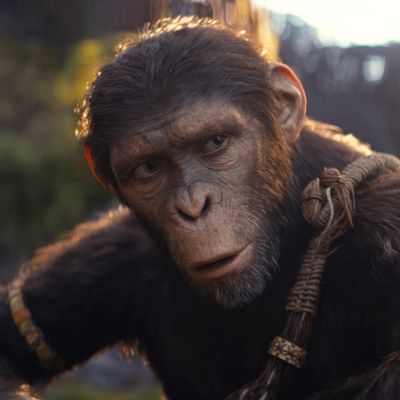
This review was published on May 10, 2024. On January 23, 2025, Kingdom of the Planet of the Apes was nominated for the Best Visual Effects Oscar.
It’s hard to believe they’re not real. The digital fur and hardened skin on the characters of the latest installment in the Planet of the Apes saga are so vividly rendered that at certain moments, we forget we’re watching computer-generated visual effects and lose ourselves in texture. We can feel the warmth of the apes when they hug, the chill when they get wet, the sting when they bleed. This is a 56-year-old movie franchise, but the most recent cycle of Apes films, which kicked off in 2011 with Rupert Wyatt’s Rise of the Planet of the Apes and continued with Matt Reeves’s two sequels, have all turned on this: We need to fully invest ourselves in these simian characters’ existence and their — for lack of a better word — humanity, because in these movies, it’s often the people who are the strange, rough monsters looming in the shadows.
At least until now. If Wes Ball’s Kingdom of the Planet of the Apes doesn’t have the grim urgency of its predecessors, that might be because the humans have been pretty much fully vanquished by now. The film takes place 300 years after Reeves’s War for the Planet of the Apes (2017), which ended with the death of Caesar (played in those films by the great Andy Serkis, utilizing motion-capture technology), the heroic and wise messianic figure who led the apes to a kind of promised land and away from the dying, vengeful humans. Now, apes hold dominion over the world, while what’s left of the humans are lone scavengers, rarely seen and weak; even our herds (we had herds) are but a distant memory, like the mighty buffalo. Instead, the apes fight themselves, and the ones that know to reference Caesar do it in the way people like to invoke ancient prophets, using the names to justify their own actions. “For Caesar!” an ape warrior declares before landing a death blow on another, thus violating Caesar’s cardinal rule: “Ape must not kill ape.” The apes, it turns out, aren’t much better at holding onto their principles than humans were.
The specific victims of these particular warriors are the apes of the peace-loving Eagle Clan, a close-knit tribe that raises birds of prey to do their bidding. When we first meet our protagonist, young Noa (played by Owen Teague), he and his two closest friends are stealing eggs from an eagle’s nest. They will then ceremonially bond with those eggs and train the baby birds once they hatch. (They always leave one egg behind in the nest. They’re not jerks, after all.) But then Noa finds a strange blanket outside an abandoned tunnel and brings it back home. The small army of apes that then invades and burns down his village, we soon learn, is after the owner of that blanket, who turns out to be a young scavenging human named Mae (Freya Allan). Soon, Mae and Noa are off on a journey of their own, each hoping to locate their respective community.
Ball previously directed the Maze Runner films — an underrated YA action franchise — and here he plays to the strengths he demonstrated in those movies. This is a world of tribal ritual, terse but youthful camaraderie, and majestic vistas. The apes live in lush, overgrown villages that used to be cities; they scramble up stunning cliffs that once were skyscrapers, the sun setting against high green hills rising from blasted cityscapes. Reeves’s films also had striking settings, but a pall of regret hung over everything, because that was the tragic, lonely end of a world — ours — while this feels like the full flower of a new one.
It all looks great, and there are interesting ideas knocking about in here, but much of the film is also a bit of a slog, because neither Noa nor Mae come across as particularly exciting, complicated characters. He’s painfully naïve, and she doesn’t say much at all. All this changes in the final act, however, which finds them in the clutches of a brutal, slave-driving bonobo monarch named Proximus (Kevin Durand), who has tacked on a Caesar to his name, an evocation of imperial hubris that revisits the ongoing idea of power seducing just about anybody, ape or man.
As the raging and curious Proximus Caesar, Durand completely takes over the movie. There’s pathos in his deluded desire to learn about history and the ways of humans, and genuine danger in the fact that he intends to use whatever he learns to accrue more power. These later scenes also add some interesting folds to Mae’s character — so much so that we might find ourselves wondering why this 145-minute film waited so long to spring such a fascinating and exciting final act on us. These last 40 or so minutes don’t just make the movie, they are the movie.
Still, these are pictures that matter in ways that modern movie franchises have largely forgotten. When other blockbusters gesture at intriguing social critiques, they often feel like they’re grabbing for topical sociocultural brownie points. But here, it’s an imperative. The Planet of the Apes movies were built on rage and shame about the world as it exists. And whatever its many flaws, Kingdom of the Planet of the Apes gets that largely right.
More Movie Reviews
- The Thriller Drop Is a Perfect Addition to the Bad-First-Date Canon
- The Accountant 2 Can Not Be Taken Seriously
- Another Simple Favor Is So Fun, Until It Gets So Dumb


